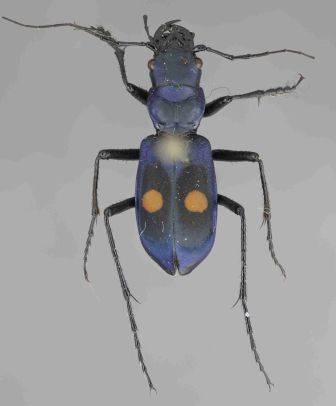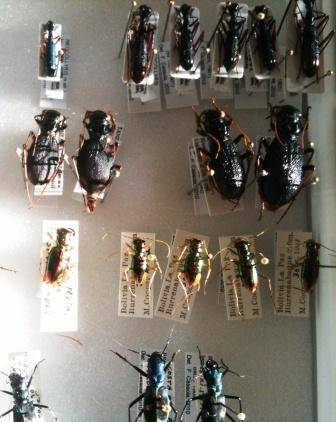When I think of Tiger beetles, (subfamily Cicindelinae) I think of William Blake’s most wondrous poem The Tyger (as was spelled by him in 1794). He was writing of that famous mammalian predator the tiger (Panthera tigris). Here is the first stanza:
Tiger Tiger burning bright,
In the forests of the night;
What immortal hand or eye
Could frame thy fearful symmetry?
Could he have been writing also of those most accomplished and fearful predators the tiger beetles? I bet Blake scholars have never thought of that!
When viewed close up, their mandibles (jaws) are truly fearsome! These beetles are as close to perfect symmetry as any other creature found in nature.
This species of Pseudoxycheila lateguttata Chaudoir ssp. peruviana Cassola, 1997
(new to the Museum’s collection and found on a collecting trip to Peru in 1984 by Martin Cooper) is a prime example of the tiger beetles’ ability to devour its prey – just look at those mandibles!
Image courtesy of Tristan Bantock 2011
Tiger beetles run very fast (approx 5 mph!) and select a varied invertebrate prey. Most species are found during the day and are prevalent in hot dry countries such as South Africa. They are heliophilic which means they love the sun – being cold blooded creatures; it gives them the required velocity to out-run their prey, or indeed their predators. Their enlarged compound eyes are extremely powerful – if you have ever encountered one, you will know that they move very quickly at the slightest detection of movement! Their exceptionally long legs not only aid speed but also help to keep them cool as they are elevated from the heat of the earth. They are found in dry sandy habitats, usually in the vicinity of water and are generally cosmopolitan. In Britain there are just five species.
Some Megacephala from Tanzania (nocturnal predators)
I have been working on some collection expansion (we have a few new species to the collection) which could not be possible without the identification skills of the world’s expert in the Cicindelinae, Fabio Cassola from Italy. For more on Fabio and the cicindelinae in general follow this link:
http://www.cicindelaonline.com/FabioCassola.htm
Each year on our sojourns to Prague Insect Fair we meet up with Fabio and give him a few hundred specimens from all over the world to identify! This March we went out to Prague with 327 unidentified specimens from various collections that have either been donated to the Museum or result from the Museum’s own collecting trips. By the time we return to Prague in October, Fabio will have identified the lot!
Neocollyris apteroides from NE India (Assam) approx 25mm length (new to the Museum's collection)
Image courtesty of Tristan Bantock 2011
In March 2010 we sent to Fabio Cassola 327 specimens of 71 taxa– as a result the following are new to the Museum’s collection:
Neocollyris (Pachycollyris) apteroides (W. Horn, 1901) (7)
NE INDIA, Assam: Bhalukpong, 27°02N-92°35E, 150 m, 28.V-3.VI.2006, P. Pacholá tko; L. Dembicky & P. Pacholátko, BMNH(E) 2006-48, 4m 3f (=male / female)
Pseudoxycheila lateguttata Chaudoir ssp. peruviana Cassola, 1997 (1)
PERU, Amazonas: Rodriguez de Mendoza, 1400 m, 29.XI.1984, M. Cooper,
1m
Ronhuberia fernandezi (Cassola, 2000) (2)
COLOMBIA, Nariño: Barbacoas, 1000 m, 23.III.1974, M.C. Cooper, 2m
Elliptica kolbeana (W. Horn, 1915) (2)
TANZANIA: Tulawaka, Biharamula, 1250 m, XI.2002, Bucket pitfall, riverine forest, University of DSM; BMNH (E) 2010-91,1m
TANZANIA: Tulawaka, XI.2002, Bucket pitfall, riverine forest, University of DSM; BMNH (E) 2010-91,1m
Cylindera (Ifasina) discreta (Schaum) ssp. subfasciata (W. Horn, 1892) (10)
INDONESIA, Borneo, Kalimantan Tengah: Busang/Rekut confl.,0°03S-113°59E; August 2001, MV light, Brendell/Mendel; Baritu Ulu 2001, BMNH(E) 2001-191, 4m 6f
Brasiella (Gaymara) balzani (W. Horn, 1899) (5)
ECUADOR, Morona-Santiago: Macas (Rio Upano), 1000 m, 7.V.1981, M.C. Cooper, 3f
BOLIVIA, Cochabamba: Villa Tunari, 800 m, 14.X.1981, M.C. Cooper, 2f
And this is just one story. We have a long history of this type of partnership with experts in many Coleoptera groups from all over Europe and indeed the world who work tirelessly and devotedly (some might say obsessionally (I know that’s not a word okay!) to contribute to the world’s knowledge of its amazing diversity.
Here is me, working tirelessly and devotedly (and always with a smile?!) on this beautiful group of beetles.
Post Script from Max Barclay from 2009/10:
We have just received a list of tiger beetles returned from identification by the world expert Fabio Cassola, including many species that we had no recent material of, and an amazing 10 species new to the collection (not bad for a well known and well collected group!); almost all of these were relatively recently acquired from field work expeditions (the details of which can be read from the list of species new to the collection below) or recovered from old unprocessed material in the last few years; some dating back to 1974!
I would like to thank all of you who have contributed to this great piece of collections development, and particular congratulations to those people who scored a 'new to NHM' species, Martin Brendell, Richard Smith, Hitoshi Takano, Donald Quicke, Jon Martin, Daegan Inward, Colin Vardy and P Hanson. (Max Barclay, Collections Manager).
Of the 271 specimens sent out on this loan in 2009/10, 10 were new to the Museum’s collection:
Neocollyris (Brachycollyris) purpureomaculata (W. Horn, 1922) (1)
W. MALAYSIA, Cameron Highlands: Tanarata, 8-26.IV.2002, Malaise trap, 10°55N-83°30E, BMNH (E) 2005-151, D L JQuicke, 1m
Collyris robusta Dohrn, 1891 (1)
BRUNEI: Bandar Seri Begam, mangrove/forest interface, 20.VI.1983, P.J. De Vries,1m
Tetracha (Tetracha) s. spixii (Brullé, 1837) (1)
PERU, Amazon: Iquitos, Rio Napo-Rio Sucusari, 3°96'46S-73°15'49W, XII.1997, lowland forest,M.V.L.Barclay, BMNH(E) 2003-49, 1f
Odontocheila cinctula (Bates, 1881) (8)
COSTARICA: Guanacaste: Golfo Dulce, 10 km N Piedrasblancas, II-III.1989, P. Hanson; BMNH (E) 1997-188, P. Hanson, 1m 1f
COSTARICA: Puntar.: Golfo Dulce, 24 km W Piedrasblancas, 200m, III-V.1989, P. Hanson; BMNH (E) 1997-188, P. Hanson, 1m
COSTARICA: Guanacaste: Estac. Pitilla, 9 km S Santa Cecilia, 700m, VI.1989, I. Gauld; BMNH (E) 1997-188, P. Hanson, 5m [2 ]
Therates apiceflavus Sawada & Wiesner, 1999 (2)
W. THAILAND: Thung Yai Wildlife Sanctuary, 15°26 (an 28) N-98°48E, 300m; Tak Province, Umphang District, Song Bae Stream, 18-27.IV.1988; evergreen rain forest, M.J.D. Brendell, B.M. 1988-183, 1m 1f [1 ]
Hipparidium pseudosoa (W. Horn, 1900) (3)
TANZANIA, Nija Panda, Mwanihana, Udzungwa Mountains NP, 07°47’27.7S-36°49’11.7E, 27-30.XI.2010, Smith R. & Takano H., general collection; BMNH (E), 2010-91, 1m 2f [1 ]
Cylindera (Plectographa) ritsemae (W. Horn, 1895) (1)
ARGENTINA, S. del Estero: Thermes de Rio Hondo, 27-28.XI.1979, C. & M. Vardy, B.M. 1980-67, 1f
Naviauxella davisoni (Gestro, 1889) (1)
W. THAILAND: Thung Yai Wildlife Sanctuary, 15°25N-98°48E, 300m; Kanchanaburi Province, Sangkhla Buri District, Mae Kasa Stream, IV-V.1988; decidous dipterocarp forest, M.J.D. Brendell, B.M. 1988-183, 1f
Naviauxella ramai Naviaux, 1991 (1)
W. THAILAND: Thung Yai Wildlife Sanctuary, 15°25N-98°48E, 300m; Kanchanaburi Province, Sangkhla Buri District, Mae Kasa Stream, IV-V.1988; decidous dipterocarp forest, M.J.D. Brendell, B.M. 1988-183, 1m
Brasiella (Brasiella) mendicula Rivalier, 1955 (3)
BELIZE: Chiquibul Forest Res., Las Cuevas Field Station, 16°44N-88°99W, 300-700m, 1.VII.1997, D. Inward, BMNH (E) 2005-78, 1m 1f [1 ]
BELIZE, Cayo, Chiquibul FR, my light sheet; Las Cuevas Research Stn., clearing, VI.2002, J.H. Martin coll.; BMNH (E) 2005-43 J.H.Martin, 1f
Tiger Tiger burning bright…






